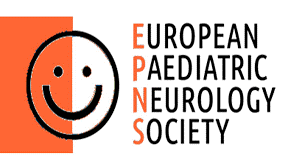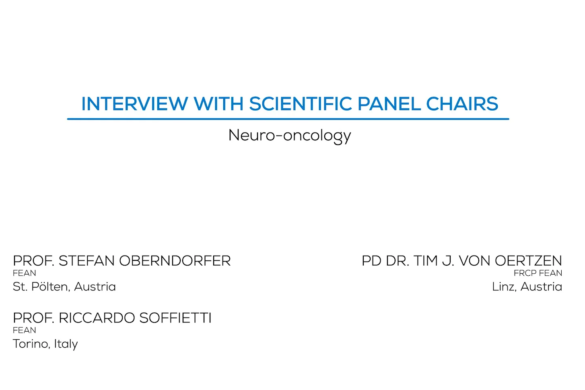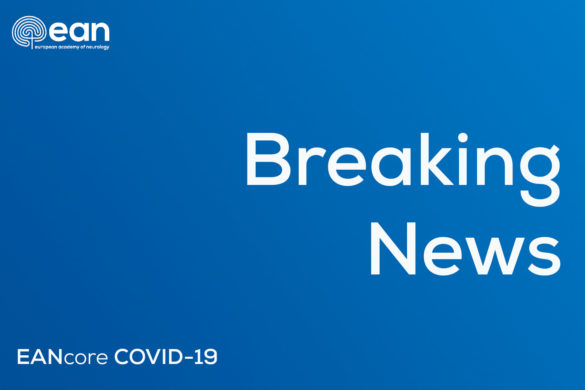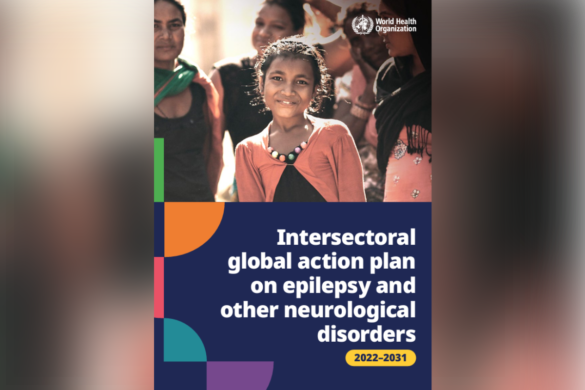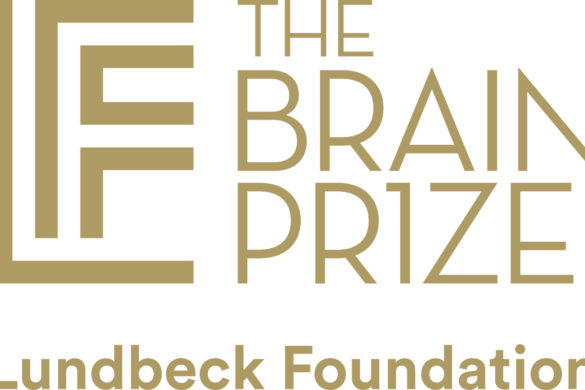Helbok R, Öztürk S
On behalf of the Members of the EAN Scientific Panel Neurocritical care
Coronavirus disease 2019 (COVID-19) is an infectious disease caused by severe acute respiratory syndrome coronavirus 2 (SARS-CoV-2). Patients with severe disease are commonly admitted to the intensive care unit (ICU) because of acute hypoxaemic respiratory failure. The need for mechanical ventilation in these patients ranges from 30% in Wuhan, China to 88% in Lombardy, Italy.1-5 ICU mortality ranges between 16% and 78%,1-5 and is higher in the elderly population, patients with comorbidities and higher grade of hypoxia on ICU admission.1-5 Most patients with severe disease are regularly placed in a prone position and a substantial number of patients receive intermittent or continuous muscle relaxants.
There are 4 major points why neurocritical care is now important during this pandemic (specific challenges and unanswered questions):
1. Neuro-invasive properties of coronavirus and brainstem involvement
The neuro-invasive potential of coronaviruses is suggested to play a role in the respiratory failure of severe patients.6 The respiratory center is located in the medulla oblongata and the respiratory rhythm is modulated from various sites of the lower brainstem, including the pons.7 SARS‐CoV infection has already been reported in the brain both in experimental animals and patients, supporting this hypothesis.8 The role of neuro-invasive manifestations in COVID-19 patients (SARS‐CoV2) are therefore currently under investigation and reports of patients with detection of SARS-CoV-2 RNA in the cerebrospinal fluid are starting to emerge. (http://www.china.org.cn/china/2020-03/05/content_75777888.htm)
2. The role of neurocritical care during the COVID-19 pandemic
Patients with severe COVID-19 disease are commonly mechanically ventilated and may develop multi-organ failure. The necessity for prolonged ICU care in these patients, multi-organ involvement and the use of muscle relaxants all put these patients at higher risk for several complications, including the development of multifactorial encephalopathy (metabolic-, toxic-, septic-, hypoxic, and others), critical illness neuropathy and myopathy (CIP, CIM), and – in ICU survivors – cognitive impairment, psychiatric and /or physical disability which is commonly referred to as the post ICU-care syndrome.
Another important issue is that some reports already indicate that severe neurological complications can occur in COVID-19 patients during hospitalization such as seizures, encephalopathy, encephalitis, and cerebrovascular events including ischemic stroke, or intracerebral hemorrhage.6, 8, 9
3. Management of neurocritical care patients during the COVID-19 pandemic
We should be aware that patients with common neurological diseases requiring ICU admission (e.g. traumatic brain injury, ischaemic stroke, haemorrhagic stroke, status epilepticus, neuro-immunological diseases and many others) have to be managed as usual, independent of COVID-19 infection status. At present, it is not known how the COVID-19 pandemic impacts on outcome of Neurocritical Care patients through direct neuro-invasive effects of the virus (SARS‐CoV2), the shift of resources for ICU-care in some areas of the world, and the potential risk of delayed diagnosis and treatment especially when the patient is under suspicion of having a COVID-19 infection.
It is also important to mention that we should be cautious to claim causality between COVID-19 infection and neurocritical care diseases and still use a critical approach to dissect the alternatives of co-incidence of two diseases or causality.1
4. Long-term follow up of COVID-19 patients
ICU survivors should be followed up and evaluated for the benefit of neurorehabilitation based on ICU complications (CIP/CIM) and the post-ICU syndrome. Moreover, based on recent data from the Zika-virus pandemic, there may be a higher risk of subacute neurological complications, including Guillain Barre syndrome,11 and other autoimmune diseases such as necrotizing encephalitis, which occurred after the influenza pandemic in 1916–17.8, 12 Early identification of autoimmune antibodies is important for predicting and classifying autoimmune neurological diseases.
In view of this severe short-/medium-term neurological and neurocognitive impairment, we request from the entire infectious disease and intensive care community not to content themselves with the short-term goal of survival and hospital discharge, but to join forces and to start as soon as possible with the appropriate neurological, neuropsychological and neurocognitive rehabilitation process to further improve long-term quality of survival of these patients.
Most important next steps to deal with coronavirus across Europe.
- Early involvement of neurologists in the care of COVID-19 patients, both in the ICU and the normal ward settings.
- Data collection in a prospective observational study to document the prevalence and severity of neurological symptoms among patients requiring critical care admission for confirmed or suspected novel coronavirus (COVID-19)
- Data collection in a prospective observational study to document the prevalence of neurocritical care diseases with and without COVID-19 infection during the pandemic.
- Understand the biology of the disease: neuropathological examination in patients with suspected neuro-invasive SARS‐CoV2 infection to assess for lower brainstem and medullary involvement.
- Follow up of COVID-19 patients to evaluate the need for neurorehabilitation especially COVID-19 patients requiring ICU care.
Authors:
Raimund Helbok, MD, Assoc. Prof. Neurology and Neurocritical Care
Department of Neurology, Neurological Intensive Care Unit, Medical University of Innsbruck, Innsbruck, Austria
Serefnur Öztürk, MD, Prof. Neurology
Department of Neurology, Faculty of Medicine, Selcuk University, Konya, Turkey
On behalf of the Members of the EAN Scientific Panel Neurocritical care
REFERENCES
1. Arentz M, Yim E, Klaff L, et al. Characteristics and Outcomes of 21 Critically Ill Patients With COVID-19 in Washington State. JAMA 2020.
2. Huang C, Wang Y, Li X, et al. Clinical features of patients infected with 2019 novel coronavirus in Wuhan, China. Lancet 2020;395:497-506.
3. Wang D, Hu B, Hu C, et al. Clinical Characteristics of 138 Hospitalized Patients With 2019 Novel Coronavirus-Infected Pneumonia in Wuhan, China. JAMA 2020.
4. Yang X, Yu Y, Xu J, et al. Clinical course and outcomes of critically ill patients with SARS-CoV-2 pneumonia in Wuhan, China: a single-centered, retrospective, observational study. Lancet Respir Med 2020.
5. Grasselli G, Zangrillo A, Zanella A, et al. Baseline Characteristics and Outcomes of 1591 Patients Infected With SARS-CoV-2 Admitted to ICUs of the Lombardy Region, Italy. JAMA 2020.
6. Wu Y, Xu X, Chen Z, et al. Nervous system involvement after infection with COVID-19 and other coronaviruses. Brain Behav Immun 2020.
7. Duffin J. Functional organization of respiratory neurones: a brief review of current questions and speculations. Exp Physiol 2004;89:517-529.
8. Li YC, Bai WZ, Hashikawa T. The neuroinvasive potential of SARS-CoV2 may play a role in the respiratory failure of COVID-19 patients. J Med Virol 2020.
9. Baig AM, Khaleeq A, Ali U, Syeda H. Evidence of the COVID-19 Virus Targeting the CNS: Tissue Distribution, Host-Virus Interaction, and Proposed Neurotropic Mechanisms. ACS Chem Neurosci 2020;11:995-998.
10. Zhao H, Shen D, Zhou H, Liu J, Chen S. Guillain-Barre syndrome associated with SARS-CoV-2 infection: causality or coincidence? Lancet Neurol 2020.
11. Cao-Lormeau VM, Blake A, Mons S, et al. Guillain-Barre Syndrome outbreak associated with Zika virus infection in French Polynesia: a case-control study. Lancet 2016;387:1531-1539.
12. Hoffman LA, Vilensky JA. Encephalitis lethargica: 100 years after the epidemic. Brain 2017;140:2246-2251.





